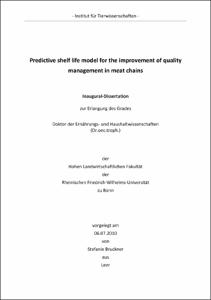Bruckner, Stefanie: Predictive shelf life model for the improvement of quality management in meat chains. - Bonn, 2010. - Dissertation, Rheinische Friedrich-Wilhelms-Universität Bonn.
Online-Ausgabe in bonndoc: https://nbn-resolving.org/urn:nbn:de:hbz:5N-22753
Online-Ausgabe in bonndoc: https://nbn-resolving.org/urn:nbn:de:hbz:5N-22753
@phdthesis{handle:20.500.11811/4224,
urn: https://nbn-resolving.org/urn:nbn:de:hbz:5N-22753,
author = {{Stefanie Bruckner}},
title = {Predictive shelf life model for the improvement of quality management in meat chains},
school = {Rheinische Friedrich-Wilhelms-Universität Bonn},
year = 2010,
month = sep,
note = {The objective of this thesis was the development of a common predictive shelf life model for fresh pork and fresh poultry based on the growth of Pseudomonas sp. as specific spoilage organism (SSO). As an element of a decision support system the model should provide predictive information to improve quality management in meat chains. To define the relevant parameters of the shelf life model, the spoilage processes of both meat types were characterised and compared under constant and dynamic environmental conditions.
Altogether, 638 pork samples and 600 poultry samples were investigated in 42 time series. The growth of Pseudomonas sp. on fresh pork and fresh poultry was investigated at five different constant and nine dynamic temperature scenarios to quantify the influence of temperature on shelf life. Additionally, several intrinsic factors (pH-value, aw-value, Warner-Bratzler shear force, D glucose, L-lactic acid, fat and protein content) were analysed during storage at 4°C and correlated to the counts of Pseudomonas sp. The collected growth data have been the basis for the development of the common predictive shelf life model.
The results showed a good correlation between the counts of Pseudomonas sp. and the sensory characteristics under constant as well as dynamic temperature conditions. It was possible to determine a common spoilage level at 7.5 log10 cfu/g for both meat types which defines the end of shelf life based on the growth of Pseudomonas sp. Temperature was identified as the most important influencing factor on the growth of Pseudomonas sp. and thus on the shelf life of both meat types. The investigated intrinsic factors had only minor or no influence and were therefore not considered in the predictive shelf life model. Investigation of the influence of dynamic temperature conditions on shelf life of fresh pork and poultry revealed similar spoilage patterns for both meat types under dynamic temperature conditions with remarkable shelf life reductions of up to two days (up to over 30 %) caused by short temperature abuses at the beginning of storage.
Based on the results, a common predictive shelf life model was developed by combining the Gompertz and the Arrhenius model. The predictive information from the model can be used in specific situations of decision making, for example by optimising the storage management from the FIFO concept (First In, First Out) to the LSFO concept (Least Shelf life, First Out). Furthermore, the predictive model can be combined with risk assessment tools which enables the development of a range of novel comprehensive quality and cold chain management systems.},
url = {https://hdl.handle.net/20.500.11811/4224}
}
urn: https://nbn-resolving.org/urn:nbn:de:hbz:5N-22753,
author = {{Stefanie Bruckner}},
title = {Predictive shelf life model for the improvement of quality management in meat chains},
school = {Rheinische Friedrich-Wilhelms-Universität Bonn},
year = 2010,
month = sep,
note = {The objective of this thesis was the development of a common predictive shelf life model for fresh pork and fresh poultry based on the growth of Pseudomonas sp. as specific spoilage organism (SSO). As an element of a decision support system the model should provide predictive information to improve quality management in meat chains. To define the relevant parameters of the shelf life model, the spoilage processes of both meat types were characterised and compared under constant and dynamic environmental conditions.
Altogether, 638 pork samples and 600 poultry samples were investigated in 42 time series. The growth of Pseudomonas sp. on fresh pork and fresh poultry was investigated at five different constant and nine dynamic temperature scenarios to quantify the influence of temperature on shelf life. Additionally, several intrinsic factors (pH-value, aw-value, Warner-Bratzler shear force, D glucose, L-lactic acid, fat and protein content) were analysed during storage at 4°C and correlated to the counts of Pseudomonas sp. The collected growth data have been the basis for the development of the common predictive shelf life model.
The results showed a good correlation between the counts of Pseudomonas sp. and the sensory characteristics under constant as well as dynamic temperature conditions. It was possible to determine a common spoilage level at 7.5 log10 cfu/g for both meat types which defines the end of shelf life based on the growth of Pseudomonas sp. Temperature was identified as the most important influencing factor on the growth of Pseudomonas sp. and thus on the shelf life of both meat types. The investigated intrinsic factors had only minor or no influence and were therefore not considered in the predictive shelf life model. Investigation of the influence of dynamic temperature conditions on shelf life of fresh pork and poultry revealed similar spoilage patterns for both meat types under dynamic temperature conditions with remarkable shelf life reductions of up to two days (up to over 30 %) caused by short temperature abuses at the beginning of storage.
Based on the results, a common predictive shelf life model was developed by combining the Gompertz and the Arrhenius model. The predictive information from the model can be used in specific situations of decision making, for example by optimising the storage management from the FIFO concept (First In, First Out) to the LSFO concept (Least Shelf life, First Out). Furthermore, the predictive model can be combined with risk assessment tools which enables the development of a range of novel comprehensive quality and cold chain management systems.},
url = {https://hdl.handle.net/20.500.11811/4224}
}






